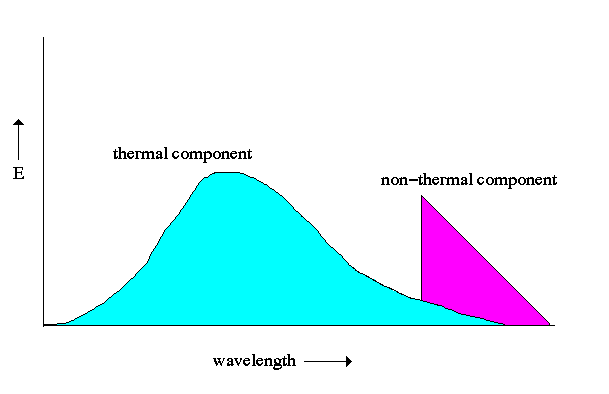
| Readings: |
Seyfert Galaxies Radio Galaxies QSO's |
Seyfert Galaxies:
In 1943, Carl Seyfert published a list of 12 otherwise normal spiral galaxies which contain anomalously bright central nuclei. These galaxies are now known as "Seyferts", a subclass of what is now called active galaxies. The following figure shows successively deeper images of the Seyfert galaxy NGC4151. In short exposures, only the bright nucleus is apparent, but deeper images reveal the normal spiral galaxy around it. In some Seyferts, the central nucleus outshines the whole surrounding galaxy.

The central nucleus light output varies on timescales of less than a year So, the emitting region must be less than a light year across, as the source cannot vary coherently on timescales shorter than this due to light travel time effects.

This central region of excess radiation is attributed to the active galactic nucleus (AGN). The engine that powers the AGN must produce tremendous amounts of energy and the best candidate appears to be an accreting supermassive blackhole. The gravitational energy of infalling matter is converted into electromagnetic radiation and emitted at all wavelengths. This separates active galaxies from normal galaxies. Normal galaxies emit most of their energy as a thermal blackbody curve due to stars and glowing gas. Active galaxies also emit an extra component due to the blackhole, both in the radio region of the spectrum by synchrotron radiation (non-thermal) and hard x-ray from the hot accretion disk.

Spectra of the nuclei in Seyferts are non-stellar in nature and display information concerning the emitting regions. From the Doppler effect, spectral lines that are broad in wavelength are emitted from gas clouds moving with high velocities. Likewise, low velocity clouds emit narrow lines. The spectra of Seyfert galaxies typically contain:
Forbidden lines are spectral lines which are very improbable (not really forbidden). Their emission indicates very low densities in order for the electrons to survive in higher orbits without collisions long enough to emit rare wavelengths.

Seyfert galaxies have been classified into two basic types:

In the narrow-line region (NLR)
Radio Galaxies:
As radio astronomers mapped the sky, they found several bright radio sources associated with distant galaxies. One of the brightest was the radio source Cygnus A. Cygnus A is a double-lobed radio source. Also notice the jets from the center. At the center sits a giant elliptical galaxy, at a distance of ~ 200 Mpc. At this distance, the lobes are separated by more than 100 kpc, and they have a radio luminosity of 1045 erg/s, 106 times greater than the radio luminosity of normal galaxies. Radio galaxies, unlike Seyferts, are generally hosted by elliptical galaxies, not spirals. Seyferts are also radio quiet.

M87, the central elliptical in Virgo, also is a radio galaxy. It is close enough that we can examine its center in detail, where we can actually see the jet in the optical.

These observations and arguments all suggest that active galaxies are powered by material accreting onto a massive central black hole in the nuclei of galaxies:

To achieve the necessary luminosity, ~ 1-10 Msun/yr must be accreted onto the black hole. Under this model, Seyfert galaxies, radio galaxies, and quasars are similar objects -- accretion powered active nuclei. They may differ in total luminosity (quasars vs seyferts) or in radio power (seyferts vs quasars/radio galaxies) or in host galaxies (seyferts vs radio galaxies).

Quasars:
Quasi-Stellar Objects, QSOs, or Quasars are the most luminous objects in the Universe. The typical quasar emits 100 to 1000 times the amount of radiation as our own Milky Way galaxy. However, quasars are also variable on the order of a few days, which means that the source of radiation must be contained in a volume of space on a few light-days across. How such amounts of energy can be generated in such small volumes is a challenge to our current physics.

Quasars were originally discovered in the radio region of the spectrum, even though they emit most of their radiation in the high energy x-ray and gamma-ray regions. Optical spectra of the first quasars in the 1960's showed them to be over two billion light-years away, meaning two billion years into the past as well.

Over a thousand quasars have been discovered, most having redshifts greater than 10 billion light-years away. The number density of quasars drops off very fast, such that they are objects associated with a time when galaxies were young.

HST imaging showed that quasars are centered in the middle of host galaxies, giving more support to the idea that the quasar phenomenon is associated with Galactic mass black holes in the middle of the host galaxies. Since a majority of the host galaxies are disturbed in appearance, the suspicion is that colliding galaxies cause stars and gas to be tidally pushed into the black hole to fuel the quasar.

This process would explain the occurrence of quasars with redshift. In the far distant past there were no galaxies, so no sites for quasars. In the early phases of galaxy formation, the galaxy density was high, and there were many collisions producing many quasars. As time passed, the number of collisions decreased as space expanded and the number of quasar also dropped.

|
|

|